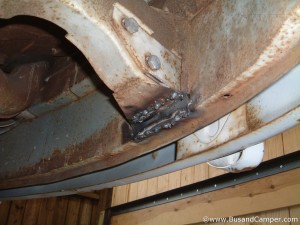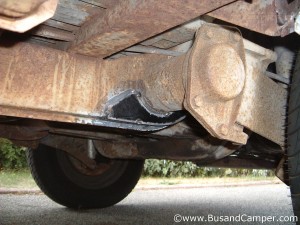For a US spec vehicle there are a number of challenges to overcome in order to get a UK registration. Perhaps the biggest thing to realise is that in most US states there are no inspections for vehicles over a certain age – not even safety inspections, hence it is possible that although the bus was being driven on the road in the US that it will require some specific work to make it meet a UK MOT test.
The definite things to address when changing a US spec bus to UK spec are
- headlights will need to be RHD spec – a simple swap to 7 inch sealed beams, maybe find some halogen H4’s here to give better lighting
- rear indicators and the associated wiring will need changing, US spec buses flash the brake lights as indicators whereas the UK requires seperate indicator and brake lights – and the indicator should be orange – the light housings are an easy swap but the wiring at the front of the bus is more challenging
But then its unlikely that the bus will then pass as all the other aspects of an MOT must be met too
- the seatbelts – basically if there are belts fitted they should work and be free of damage, all cars after 1965 should have front seatbelts fitted, if they are retractable then they should retract, lap belts should be acceptable – strictly 3 point belts apply after 1981 for the front seats. Probably want to go ahead and put retractable belts in. Rear seats do not have to have belts
- the structual integrity of the chassis and underside needs to be sound, usually this is the issue that takes time to fix – even with so called California driven buses – as we saw with 67 13w
- brakes need to be in tip top condition – the US does not test the brakes on rollers like the UK, hence each wheel will need to be working, the emergency brake too
- exhaust leaks and smoking exhaust – fortunately the emissions for UK cars are not as strict for this age of vehicle – just as well as tuning a carburetor for reduced emissions is non trivial
- steering – no play, there is limited adjustment to the boxes on a bus, usually the wear is found in the ball joints (6 in total) and the centre pin on the beam
- front suspension – adjustment of link pins is possible on split windows, hope the king pins were kept lubricated and do not require replacement and as for the bay windows – if the ball joints are worn on a bay window better get those arms off and replaced
- Tyres, lighting, hooters, handles, steering etc all need to be in good condition
Here are some of the things we had to do to get the bus through the MOT, the most common area is structual corrosion – specifically the manual says there should no excessive corrosion in a ‘prescribed area’ — within 30 cms of certain safety related components, e.g. brakes, steering, suspension, seat belt mountings etc.
For a bus that typically means looking carefully at where the bumper mounts to the front nose, which on ours needed a small patch, note the surrounding area within 30cm of the support would be inspected with an MOT standard finger / thumb or inspection tool, it is common for this inner nose to be heavily corroded

We also had to patch an area around the rear torsion bar support – this was unusual and not normally seen, there was a lot of sand in the bottom of the channel when we dug out the corrosion, perhaps this was the cause, anyhow this area is definitely within 30cm of a major load bearing structure – this is the mock up of replacement parts, we seam welded the whole thing after this – quite the structual support there

Next up was the wiring and lights